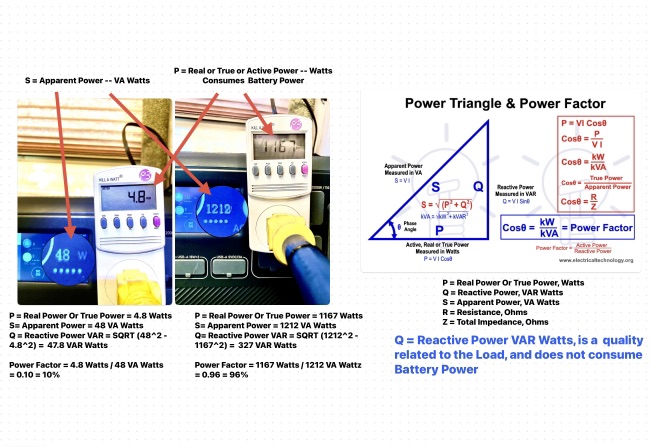I have the ac180 fully charged powering a freezer. I use my ac200 max to charge this when it’s low. After the ac180 is fully charged I can still see 100 watts getting pushed out of the ac200max and no power into the ac180 in the app. When the freezer kicks on I can then see 70 watts inbound on the ac180 and 70 going to the freezer. The ac200max shows 70 outbound as well. This is what I would expect. My question is this… why would I still be using 100 watts when nothing is happening? Would like to use this as a ups but it seems I would be using 100 watts and hour for no reason. Thanks!
The power Watts displayed on the AC200MAX is the Apparent Power, VA Watts. It does not display the Active, True Power, Watts, consumed from the battery in the AC200MAX.
.
NOTE: It is quite possible that all the Bluetti Power Stations, display Apparent Power, and not the Active, True Power.
.
On AC circuits understanding Power is a bit complex, loads on a Power Source can have Reactivate Power, VAR Watts.
Reactive Power, VAR Watts, does NOT consume battery power from the power source, but it is a property of the load devices / appliances related to the Resistance and Impedance of the loads on the power source. This can cause a phase difference between the AC sinusoidal Volts, and the sinusoidal Amps.
.
There is a relationship between Apparent Power, VA Watts, and Active, True Power, Watts, and Reactive Power, VAR Watts. The relationship can be described by the Power Triangle below.
.
For my self, usually I measure the Active, True Power of a load (devices / appliances) using a Kill-A-Watt meter plugged into one of the 120 Volt outlets of the AC200MAX. See example below.
.
For my AC200MAX + a B230 Battery Expansion have measured that the AC200MAX, has a self-consumption of ~ 31 Watts when DC & AC circuitry is powered On, even though there are no loads connected to the power station, let’s call this the Standby Mode.
The measurement was performed overnight, by noting the SOC% at 6 pm (98%), DC & AC on, and at 7 am (85%). With the difference in SOC%, knowledge of the total battery capacity of the power station, and the time laps of: 6 pm - 7 am = 13 hrs, we can calculate the standby, self-Consumption, Active, Real, True power consumed from the batteries, no external load:
.
AC200MAX + 1 Bat, – DC & AC On, On Standby, No Load
– AC200MAX + 1 Expansion Bat = 4096 Wh
– After 13 hr, No Load, (95% - 85%) X 4096 Wh / 100 = 410 Wh
– 410 Wh / 13 hrs = 31.5 Watts
= Real, True, Active Power Draw from AC200MAX Batteries On Standby.
.
Likely all Power Stations, have a Standby, self-consumption of battery power, Watts.

In UPS mode there is still a significant power consumption. Especially with AC on. And the Bluetti internal electronics always run off battery power, even when the Bluetti is connected to good utility power. This causes the battery to go into timely discharge / recharge cycles from 99% to 100%.
With my AC300 I decided not to use the UPS mode. I use a regular server UPS for short outages and keep the Bluetti charged, off and standby for longer power outages.
I hope Bluetti will make a true UPS mode some day where all internal electronics are ran off utility power and the battery is only used when the utility power fails.
@bluetti_piels1026comcastnet Based on this problem I consulted the technical engineer and got the following reply for your reference:
AC200MAX and AC180 both have inductance and capacitance inside the machine, as long as the two are connected there will be reactive power 100w, in fact, there is no energy consumption.
Wow, … so using the Power Triangle, in this case, with the AC180 at 100% SOC%, and connected to an outlet of the AC200MAX, the Apparent Power displayed on the AC200MAX of 100 VA Watts, actually equals 100 VAR Watts of Reactive Power for the AC180. Reactive Power VAR Watts = No Power consumed from the AC200MAX batteries. It would be interesting if this could be simply validated via an AC180 plugged to a Kill-A-Watt meter plugged to an AC200MAX outlet.
I hope Bluetti will make a true UPS mode some day where all internal electronics are ran off utility power and the battery is only used when the utility power fails.
The behaviour you describe of the Bluetti is a ‘true’ UPS.
There are (in general) 3 types of UPS, ranked from least-best to best.
- Standby
- Line-Interactive
- Online
The behaviour you are describing of the Bluetti is of the ‘Online’ type. That is, all mains power goes into the battery, then appliance power is delivered by that battery whether mains power is still live or whether it has lost mains power. This is the best type of UPS, and usually the most expensive. This is typically the type you’d get for entire datacenter coverage.
Your description of what you view as a ‘true’ UPS is accomplished by the Line-Interactive and stanby types of UPS. These are the ‘cheapy’ solutions for UPS, the type pushed in consumer computer and electronics stores for $200-$600-type ranges, as they are much cheaper (usually) than the more professional/commercial oriented online type of UPS.